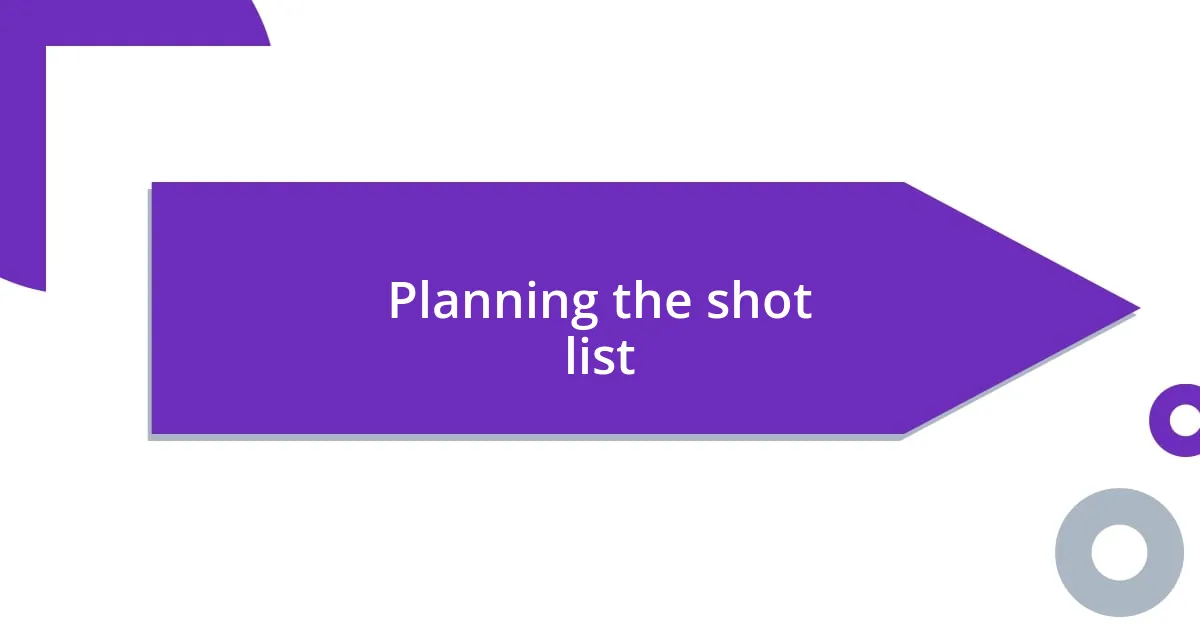Key takeaways:
- Understanding the shoot concept is crucial for guiding creative direction and emotional connection with the project.
- Defining clear objectives and goals helps maintain focus and enhances the storytelling aspect of the photography.
- Researching locations and lighting allows for adaptability and can significantly influence the mood and outcome of the shoot.
- Coordinating with the team ensures clear communication and teamwork, which can lead to spontaneous and memorable moments being captured.

Understanding the shoot concept
Understanding the shoot concept is the foundation of any successful project. I remember one time, I was so excited to start a new shoot, but I had overlooked the importance of a clear concept. It’s easy to get caught up in the logistics or the equipment, but without a strong concept, the shoot can feel aimless.
When I begin conceptualizing a shoot, I often ask myself, “What story am I telling?” This question helps me connect emotionally with the project. I recall a particular shoot where I focused on capturing the essence of childhood – playful, spontaneous, and joyful. This clarity brought energy to my work, making every click of the shutter purposeful.
The concept serves as a North Star, guiding decisions from location to lighting. I encourage you to take some time to really think about the vibe you want to evoke. For instance, in a recent project highlighting urban life, I envisioned vibrant colors and dynamic compositions that reflected the city’s energy. This clear vision not only shaped my strategy but also elevated the resulting photographs, which, if I may say, truly resonated with the audience.

Defining objectives and goals
Defining objectives and goals is a pivotal part of my preparation process. When I set out to define what I want to achieve, I think about both the emotional response I want to evoke and the practical outcomes that will guide my efforts. For instance, during a promotional shoot for a local business, my goal was not just to create attractive images, but to convey the brand’s unique story and ethos. This dual focus on feeling and function helps me stay aligned with my vision throughout the shoot.
Here are some key points that guide me in defining objectives and goals:
- Identify the primary message: What core idea or feeling do I want to communicate?
- Set measurable outcomes: Are there specific metrics I can use to judge the success of the shoot, like engagement levels or sales increases?
- Consider the audience: Who am I trying to reach, and how can I connect with them emotionally?
- Resolve the context: Where will these images be used, and does that need specific adjustments in style or format?
Establishing clear objectives not only aids in maintaining focus but also fuels my creative energy. I remember planning a wedding shoot where my goal was to capture the couple’s love story authentically, which led me to document candid moments throughout the day, providing a more genuine narrative. This approach transformed the final album into a beautiful reflection of their unique journey, rather than just a collection of posed images.

Researching locations and lighting
Researching locations and lighting is a critical step in my preparation for a shoot. I often find myself wandering through potential sites, soaking in the surroundings and imagining how the light will dance throughout the day. Just last month, while scouting a beach for a sunset shoot, the shifting clouds created a dramatic scene. I visualized how the soft, golden light would wrap around my subjects, elevating the emotional tone of the photos. It’s remarkable how a location can shape the mood — it’s like selecting a backdrop for a stage where stories unfold.
When I research lighting, I pay close attention to the time of day and weather conditions. I keep a weather app handy because unpredictable sunlight can make or break a shoot. For instance, I recall a time when I arrived at a forest location with plans for a moody, shadow-filled aesthetic, only to find the sun was uncharacteristically bright that day. I had to pivot quickly, utilizing the bright light to capture vibrant colors instead, creating a fresh perspective. Being flexible and adapting to the available lighting can lead to unexpected and beautiful results.
Now, let’s look at how various locations and their corresponding lighting conditions can impact our creative outcomes.
| Location Type | Key Lighting Considerations |
|---|---|
| Beach | Soft, golden hour light for warmth; avoid harsh midday sun. |
| Forest | Shadow play for mood; consider the canopy effect influencing light levels. |
| Urban | Vibrant colors in dusk light; streetlamps create dramatic contrasts at night. |
| Studio | Complete control over lighting; ideal for planned setups. |

Planning the shot list
Creating a shot list is something I truly cherish in my preparation process. It acts as a roadmap, guiding me through the chaos of a shoot. I remember a corporate event I covered where every moment felt critical. I had crafted a detailed shot list that included key speakers, candid interactions, and the venue’s ambiance. It not only kept me organized but also helped me capture those fleeting moments that tell a more profound story.
As I develop my shot list, I often ask myself, “What moments will resonate most with my audience?” This question propels me to think beyond the obvious. For example, during an engagement session, I didn’t just focus on the couple’s poses but included a moment of them laughing at an inside joke. That candid shot became one of their favorites because it encapsulated their unique connection. So, while it’s easy to list poses, adding those personal touches truly elevates the final collection.
I also ensure to leave room for spontaneity within my shot list. Just last week, while photographing a family in the park, I spotted a playful dog running toward us. A quick adjustment in my list allowed me to capitalize on the unexpected moment, resulting in a delightful series of shots that the family treasures. How often do we miss out on these joyful surprises when we stick too rigidly to a plan? Balancing structure with flexibility is essential for capturing the essence of any shoot.

Selecting and preparing equipment
Selecting the right equipment is often where my creativity begins to take shape. I learned early on that each shoot calls for a unique set of tools tailored to the specific vision I want to achieve. For instance, while preparing for a wedding, I relied on my trusty 50mm lens—its ability to create stunning portraits in low light has always captivated me. I always ask myself, “What gear can elevate this moment?” This question helps me strategize and ensure I’m never caught off guard on the big day.
Once I’ve selected my gear, I go through a thorough preparation process. I check batteries, format memory cards, and clean lenses to guarantee everything is in peak condition. I recall a time when I overlooked charging my backup battery before a sunrise shoot, and it nearly left me stranded when my primary battery died. Now, I always double-check my gear the night before, allowing me to feel a sense of calm and readiness as I step out to capture beautiful moments.
Additionally, I find it crucial to familiarize myself with my equipment well before the shoot. Practicing with new cameras or settings helps me avoid fumbling during critical moments. I remember once working with a rented camera; the unfamiliarity led to anxiety when a family wanted a quick group photo right after their ceremony. Thankfully, a little pre-shoot practice allowed me to adapt quickly, capturing the magic of their joy without missing a beat. How often do we let fear of the unknown disrupt our flow? By investing time in preparation, I arm myself with confidence and creativity, setting the stage for successful captures.

Coordinating with the team
Coordinating with my team is a pivotal part of my shoot preparation. I always start by having candid conversations with everyone involved, including assistants, stylists, and clients. Last year, during a promotional shoot for a local business, we had a brainstorming session ahead of time. It was during this chat that we uncovered a shared vision that not only made the shoot smoother but also breathed life into the concept, resulting in photos that truly resonated with the brand’s identity.
During the coordination phase, I focus on clear communication. I remember a portrait shoot where my assistant came up with a fantastic idea to switch locations at the last minute. I trusted her instincts, and we ended up capturing incredible shots against a vibrant sunset backdrop. Have you ever put your faith in someone else’s creativity? It can lead to beautiful surprises and evoke powerful emotions in your work.
As the day approaches, I also review roles and timelines with my team. This ensures everyone is on the same page, preventing last-minute confusion. Just a few months back, I was part of a wedding shoot, and I felt a wave of reassurance when we discussed everyone’s responsibilities. When it came time to execute, our tight coordination allowed us to capture the day seamlessly, preserving those cherished moments the couple would remember forever. Isn’t it amazing how teamwork can amplify the magic of a shoot?

Reviewing and refining the plan
As I sit down to review and refine my plan, I find it to be an essential part of preparation. It’s the moment when all those initial ideas and inspirations start to solidify into a tangible roadmap for the shoot. I take a step back and ask myself, “Are there any gaps in my vision?” This reflection allows me to identify potential challenges early on. For instance, during a recent fashion campaign, I spotted a missing element in the styling details. Adjusting the wardrobe choices at the last minute not only elevated the concept but also gave the shoot a fresh perspective.
I often find it helpful to create a checklist based on my initial plan, detailing each shot I want to capture along with the corresponding settings and lighting conditions. This method came in handy last summer when I was navigating a beach shoot where the light changed rapidly. By refining my plan with specific details, I was able to make quick adjustments, ensuring I didn’t miss any stunning moments as the sun dipped below the horizon.
While reviewing the plan, I also consider my emotional state leading up to the shoot. Have you ever felt overwhelmed by the excitement or pressure before a big project? In those moments, I remind myself to breathe and reconnect with my passion for photography. I recall a particularly nerve-wracking engagement shoot where I felt the pressure to deliver something extraordinary. By refining my plan and focusing on my emotional preparedness, I turned that nervous energy into creativity, capturing genuine moments that truly showcased the couple’s connection. Revisiting and refining the plan isn’t just about logistics; it’s about nurturing the soul of the shoot.












